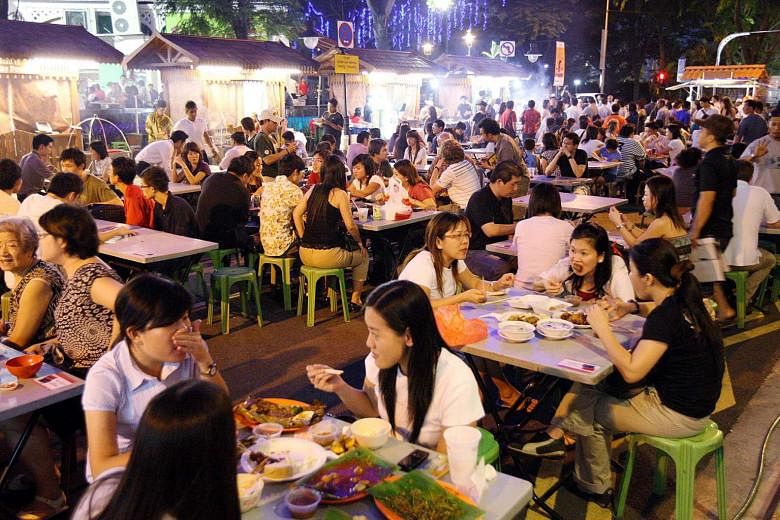FOOD, FOODWAYS AND FOODSCAPES: CULTURE, COMMUNITY AND CONSUMPTION IN POST-COLONIAL SINGAPORE
Edited by Lily Kong and Vineeta Sinha
World Scientific paperback/247 pages/$29.96 with GST from Books Kinokuniya
Two Mondays ago, Singapore's Jumbo Group of restaurants with its signature chilli crab went public, with its share price soaring by 58 per cent on its first day of trading here.
Market watchers such as Mr Derek Lau, chief executive officer of Heliconia Capital Management, told Bloomberg News that the enterprise had "a good recipe for investment" and that its Singapore cuisine "can be world dishes".
-

-
FIVE QUESTIONS THIS BOOK ANSWERS
1. What can food and eating tell you about yourself and your community?
2. How has the relentless renewal of Singapore's cityscape changed the way we buy, cook and eat food?
3. Why do people yearn for foods and eating places of the past?
4. How, and to what extent, has social media influenced the way we regard food and eating?
5. How, and to what extent, has Singapore cuisine galvanised taste buds internationally?
-
Just a minute
The good
1. This book is not the first attempt to chart Singapore's food history, but it certainly is one of the most accessible and comprehensive. All nine writers should be applauded for putting across their points in a way that resonates with everyone, evoking beautifully many shared experiences with food.
2. The writers tried hard to come at the chosen subject, food, a somewhat tired discussion point by now, from intriguing angles. So, for example, Adeline Tay asserts that the story of Singapore can be told through the biscuits that its people like to eat. The book's co-editor, Vineeta Sinha, reveals that there is a survey to track how often people in Singapore have meals at home. The Electrolux Asia Pacific Food Survey showed last year that 75 per cent of its Singaporean respondents - who are among a total of 5,000 respondents from 10 countries - who are above the age of 50 have taught their children how to cook.
The bad
1. While pictures of food are not essential to a book on food, once authors decide to include them, there should be a regard for production values. The reader would be hard-pressed to say that the smattering of food photographs in this volume is appetising.
2. There is a sense that not all of Singapore's cultures are given equal time in this book. A stark example of this is the photographic representation of a mamak, or mama, shop - with a Chinese man as its sole focal point. While mamak shops have the same function as traditional sundry shops, they do not have the same roots. The word "mama" means "maternal uncle" in both Tamil and Hindi, and has colloquially come to refer to one-stop shops, often no more than cubbyholes, run by Indian proprietors. Also, one should not assume that non-English words such as tikam-tikam - the Malay name for a schoolyard guessing game - can be spelt any which way, as this book does with "tikum tikum"; that is akin to spelling Monopoly as Mohnohpohlee.
The iffy
1. Seeing as the authors of this book wanted to be as comprehensive as possible, they might have considered examining how migrants to Singapore in recent years, such as Filipinos and mainland Chinese, have influenced the quality of food choices and cooking styles here. This is significant because many migrants now run food stalls.
The person said to have first cooked chilli crab, Madam Cher Yam Tian, would likely never have dreamt that her recipe of mud crabs with egg and bottled chilli sauce, which she sold from a pushcart in the 1950s, would excite gourmands internationally today.
The impact of such Singapore cuisine on global consciousness, as well as the Singaporean psyche, is explored from many facets in the just-launched Food, Foodways And Foodscapes, an anthology of essays by nine academics, namely Lily Kong, Vineeta Sinha, Chua Beng Huat, Lai Ah Eng, Harvey Neo, Jean Duruz, Kevin Low, Adeline Tay and Amy Tan. Kong and Sinha are also the book's editors.
Such global awareness of Singapore cuisine in under 50 years is remarkable when you consider that Time magazine began making much of sushi only in the late 1980s and pad thai in the late 1990s.
Each of the academics riff on topics as diverse as why Singapore has no pig farms today (Neo's piece) to how urban renewal changed the food habits of the denizens of Bukit Ho Swee (Chua's).
The book is part of publisher World Scientific's series on 50 years of nation-building. All nine writers,who are from different disciplines, have given the relatively new field of food as social history a distinct Singaporean complexion.
The best example of this is Lai's study of what the kopitiam means to Singaporeans and how the idea of it has helped the many communities here mingle.
After showing in keen observations how much kopitiams are a microcosm of Singapore society, she suggests this about new- fangled kopitiams such as Toast Box, which she calls "pastiches": "The local history these kopitiams draw from and the nostalgia they create are attempts at placing the local in the global and expressing Singapore's position and identity in a globalised society through food."
Lai's essay, with contributions from Lee Shuyun Michelle and Lin Jialiang, is also the most coherent and structured of the book's offerings.
Her co-authors go about their chosen topics such that there is a sense that they dithered over what they wanted to say.
For example, in discussing the cornucopia of tidbits available in Singapore, Tay has the intriguing idea that the snacking habits of Singaporeans shed much light on personal, social and national histories.
That is a fresh lens with which to examine the maturing of Singapore in the past half century.
But, alas, she gets caught up in an analysis of how biscuits are a barometer of evolving life in Singapore.
Low and Duruz probe why people are nostalgic about home-cooked and other beloved eats, such as old bakery Le Cafe's pineapple balls, beancurd tarts and "retro-licious" butter cream cakes.
Tan brings everything up to the minute with her assured discussion of how social media and its encouragement to consumers to "binge gaze" is changing attitudes and behaviour towards eating.
Sinha, who probes why few working women cook, then dangles this tantalising morsel of inquiry: "I would argue that apart from doing the cooking, learning and teaching cooking, reading about cooking and watching others cook are additional, emergent consumption practices in the food domain and merit scholarly engagement and scrutiny." But, like Tay, she does not deal with that at any length.
Kong's essay focuses on the many aspects of globalisation of food and notes the important caution by sociologist Allison James that one should question whether food in a globalised world can still be used as a distinguishing marker of cultural identity.
That is because foodways, or what, how and why people eat, are now "so fluid and temporal".
Crucial to any book on food, some of the writers have taken pains to describe, or include descriptions of, food that will make readers salivate. Here is one, from Low's piece: "Ah Mm's little flat was perpetually filled with this distinctive amalgamation of smells of fried lard, peeled onions, garlic, fried chilli paste."
There are also mentions of homegrown food heroes, including hawker food champion K F Seetoh who gave Singapore its first credible and reliable hawker guide.
The book might, however, have been bolstered by the inclusion of some of their voices, as they are pretty authoritative inter- nationally.
Seetoh, for one, friend of Anthony "Kitchen Confidential" Bourdain, influenced Bourdain to open a Singapore-style food market in New York in 2017.
All told, this book is an excellent starting point for anyone keen to understand the ways in which Singaporeans think about, and enjoy, food.


